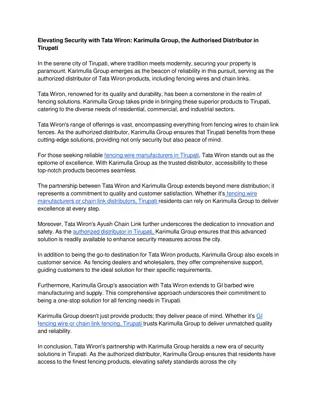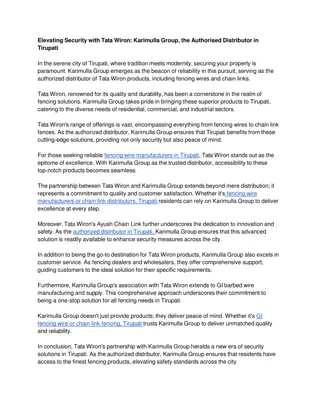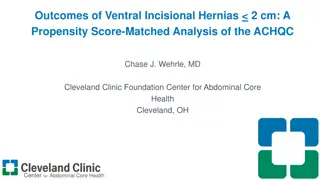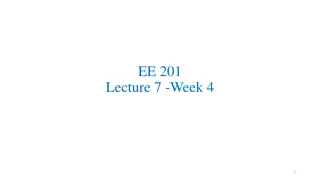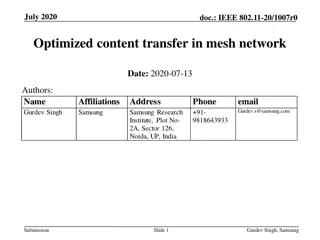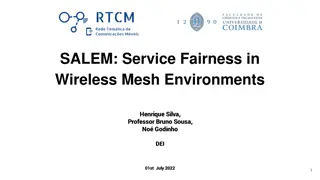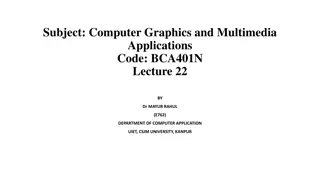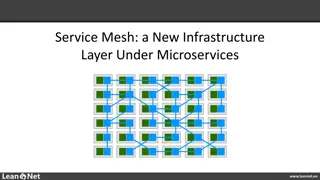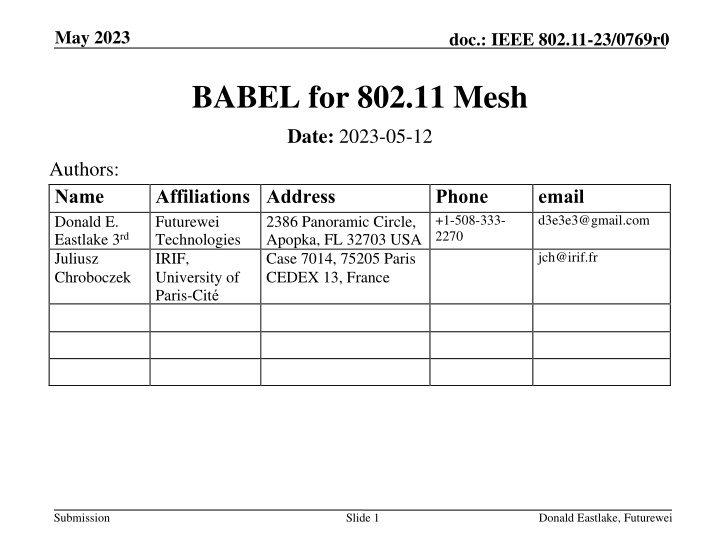
Babel Routing for IEEE 802.11 Mesh Networks
Explore the introduction of the Babel routing protocol for IEEE 802.11 mesh networks, allowing for diverse path selection protocols and link metrics. Learn why 802.11 is interested in Babel, its effectiveness in mixed-quality networks, and its flexibility with various link metrics. Discover how Babel can enhance mesh network performance and adapt to different mesh conditions.
Download Presentation

Please find below an Image/Link to download the presentation.
The content on the website is provided AS IS for your information and personal use only. It may not be sold, licensed, or shared on other websites without obtaining consent from the author. If you encounter any issues during the download, it is possible that the publisher has removed the file from their server.
You are allowed to download the files provided on this website for personal or commercial use, subject to the condition that they are used lawfully. All files are the property of their respective owners.
The content on the website is provided AS IS for your information and personal use only. It may not be sold, licensed, or shared on other websites without obtaining consent from the author.
E N D
Presentation Transcript
May 2023 doc.: IEEE 802.11-23/0769r0 BABEL for 802.11 Mesh Date: 2023-05-12 Authors: Name Donald E. Eastlake 3rd Juliusz Chroboczek Affiliations Address Futurewei Technologies IRIF, University of Paris-Cit Phone +1-508-333- 2270 email d3e3e3@gmail.com 2386 Panoramic Circle, Apopka, FL 32703 USA Case 7014, 75205 Paris CEDEX 13, France jch@irif.fr Submission Slide 1 Donald Eastlake, Futurewei
May 2023 doc.: IEEE 802.11-23/0769r0 Abstract 802.11s Mesh provides the hooks to support a variety of path selection protocols and link cost metrics in different meshes. Different network environments and applications may be best supported by different path selection protocols and link metrics. There is interest in the IETF in specifying an alternative path selection protocol and/or link metric for mesh based on the Babel routing protocol. This presentation requests that a liaison be sent to the IETF indicating that the 802.11 WG has no objection to this. Submission Slide 2 Donald Eastlake, Futurewei
May 2023 doc.: IEEE 802.11-23/0769r0 Donald Eastlake is a Co-Chair of the IETF BABEL WG and was in the past Chair of IEEE 802.11s. The authors of this presentation are speaking for themselves and do not officially represent the IETF or the BABEL WG. Submission Slide 3 Donald Eastlake, Futurewei
May 2023 doc.: IEEE 802.11-23/0769r0 Why Should 802.11 be Interested? 802.11s mesh depends on a Path Selection Protocol and link metric to determine how to forward frames. It was realized, when 802.11s was developed, that different path selection protocols would be suitable for different mesh conditions. Thus 802.11 mesh was designed to be extensible by additional Path Selection Protocols and link metrics, including those developed outside of 802, although only one of each can be used in any particular 802.11 mesh. Submission Slide 4 Donald Eastlake, Futurewei
May 2023 doc.: IEEE 802.11-23/0769r0 Why Should 802.11 be Interested? Different Path Selection Protocols and link metrics may be best for different meshes. Meshes can vary in how dense, dynamic, large they are and in the computational and storage capabilities of their mesh stations. The default path selection protocol and the only one specified in the 802.11 Standard is HWMP (Hybrid Wireless Mesh Protocol). There are implementations/uses of 802.11s mesh and HWMP. See https://en.wikipedia.org/wiki/IEEE_802.11s Submission Slide 5 Donald Eastlake, Futurewei
May 2023 doc.: IEEE 802.11-23/0769r0 Why Babel? In practice, Babel had proven to be particularly effective in networks consisting of a mixture of high and low quality links such as wireless or hybrid wireless/wired networks. Babel is very flexible on the link metric used as long as it is monotonic and thus should work well with the 802.11 Air Time metric. (Existing Babel implementations tend to use link metrics based on multicast loss rate or RTT.) It has done well in the European Battlemesh contests. See https://battlemesh.org/BattleMeshV8 (Results tabs). Submission Slide 6 Donald Eastlake, Futurewei
May 2023 doc.: IEEE 802.11-23/0769r0 Why Babel? Babel is standardized in the IETF in RFC 8966: The BABEL Routing Protocol, https://datatracker.ietf.org/doc/rfc8966/ Multiple opensource implementations: BIRD https://gitlab.nic.cz/labs/bird/tree/master/proto/babel FRR https://docs.frrouting.org/en/latest/babeld.html See https://en.wikipedia.org/wiki/Babel_(protocol) Submission Slide 7 Donald Eastlake, Futurewei
May 2023 doc.: IEEE 802.11-23/0769r0 Why Babel? Babel is based on the distance-vector algorithm (also known as distributed Bellman-Ford) augmented with mechanisms for loop avoidance and starvation avoidance. Babel has been described as RIP on speed since it is based on the same principles but has refinements that make it react much faster to topology changes. Babel in depth: https://www.irif.fr/~jch/software/babel/babel-20150804.pdf (References earlier RFC 6126 which has been obsoleted by RFC 8966) Submission Slide 8 Donald Eastlake, Futurewei
May 2023 doc.: IEEE 802.11-23/0769r0 Babel for 802.11s Mesh An 802.11s Path Selection Protocol based on Babel would be simpler than the existing RFC 8966 network layer specification. There would be no need to carry prefixes, just sets of MAC addresses. There would be no need to distinguish between router- id and address the AC address can serve as both. Thus it would be a simpler and cleaner protocol. Submission Slide 9 Donald Eastlake, Futurewei
May 2023 doc.: IEEE 802.11-23/0769r0 Next Step The IETF is unlikely to allow work on this without an indication from IEEE 802.11 that we do not object to the work. Therefore, it is proposed that a motion be adopted at the Closing Plenary to approve a Liaison to the IETF indicating no objection. See 11-23-0812-00-0000 Submission Slide 10 Donald Eastlake, Futurewei
May 2023 doc.: IEEE 802.11-23/0769r0 References IEEE Std 802.11-2020, Section 4.3.21, etc., December 2020 IETF RFC 8966, The Babel Routing Protocol, January 2021, https://datatracker.ietf.org/doc/rfc8966/ Wikipedia article https://en.wikipedia.org/wiki/Babel_(protocol) IETF Babel WG, https://datatracker.ietf.org/wg/babel/about/ Submission Slide 11 Donald Eastlake, Futurewei

